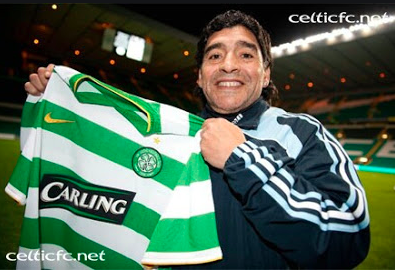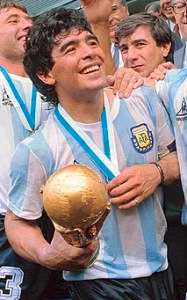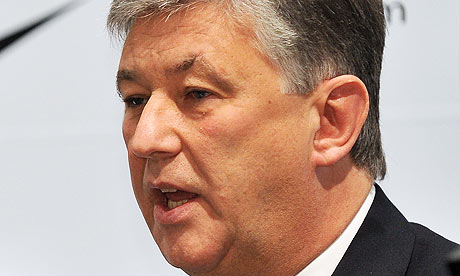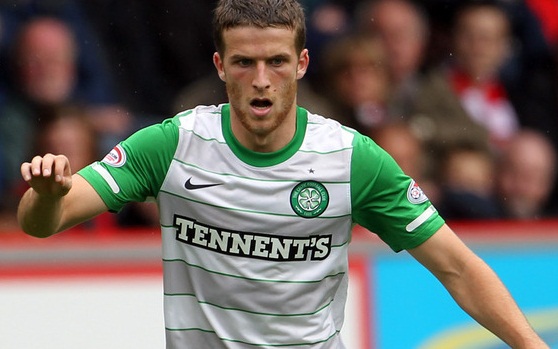By Critical Bill
No this is not another piece about our (so far) annus horribilis season. Diego Armando Maradona died on the 25th of November 2020. He is – by far – the greatest player I ever watched. He scored the greatest goal I’ve ever seen. His record in the game was truly astonishing. I sincerely doubt there will ever be anyone like him.
He was born in 1960. The fifth child to a family that lived in a Buenos Aires barrio called Fiorito. Whilst the Argentine capital does not have the favelas of its neighbour Brazil, none the less, Maradona was born into real poverty. And of course at the time, one way out of such circumstances was football. By aged twelve as a ball boy, he would entertain spectators at Argentinos Juniors with his ball skills before the big match. He wasn’t even 16 when he made his first team debut. At this point even the rest of the World was beginning to notice.
I first came across Maradona in the foreign column of Shoot magazine. In 1978 it referred to this prodigious talent who might make the Argentine World Cup Squad on home soil. He didn’t. I had actually forgotten all about him when I went with my father and sister to watch Argentina take on Scotland at Hampden the following year.
I went there looking to see a Scotland team take on the likes of Leopoldo Luque, Rene Houseman and Daniel Passarella. But from the kick off, all eyes started to focus on their stocky No.10 with a very short haircut (he had just finished National Service) . Smaller than anybody else on the pitch, he would immediately dart past a couple of Scotland players every time he got the ball. In Argentina they call it Gambetta – the art of dribbling. We were watching him take the ball at any point on the pitch and just run with it. At half-time a goal down, every fan was going, “Who on Earth is that No.10”.
Into the second half and he continued to torment Scotland. Argentina went two up and then in the seventieth minute, Maradona was played through on goal. He feigned to play the ball across the six yard box, waited for George Woods to fall for the dummy and then rolled it inside Wood’s near post. It was his first international goal. I was in the main stand and I immediately stood up and applauded.
Going home from the game, in a match that included Dalglish, Hansen, Passerella and Luque, I knew I had seen something that was on a different level. I got home and made a point of finding out that the players’ name. When I read it was Maradona, I remembered the Shoot article.
A few months later Argentina would go to the World Youth Championships in Japan and win it. Maradona at this time, he was still with Argentinos Juniors. Of the many clubs in Buenos Aires, they are one of the smaller sides. In 1981 he would join his boyhood heroes and Argentine Giant, Boca Juniors.
Together with Miguel Brindisi (a star of the Argentine 1974 WC Squad) and Uruguayan Ariel Krasouski, they formed a prodigious midfield and it would lead to Maradona’s only league Championship in Argentina. I used to love ITV’s “Off the Ball” when about once a month they have a piece called “Maradona Magic” and it would be highlights of his goals and moves in the Argentine League.
There was no debate in 1982 as to whether he would make the Argentine WC squad. He was to be their star. A team made up mostly of the remnants from 78 with Maradona and a few others from 1979 World Youth Champions, made Argentina one of the favourites. But the Falkland Conflict had occurred on the eve of the tournament. (A “Shitty War” as defender Alberto Tarantini correctly called it) The mood in the country had dampened and in the opening match Maradona was subdued by stubborn Belgian defending.
They did get out their group but would face a second group consisting of favourites Brazil and Italy. The Italians had come into the game under pressure but Claudio Gentile – using fair means and foul _ stopped Maradona getting the ball. As Mario Kempes said, “Gentile would follow you to the toilet if you went there”.
A defeat against Brazil meant an end to Argentine involvement in the World Cup and Maradona got sent off after lashing out in frustration at Batista. Maradona had already agreed to join Barcelona after the tournament for a world record sum, and there was already unease at the Catalan giants as to Maradona’s temperament following a very lousy and fractious WC Campaign.
None the less Maradona went to the Non Camp and Barcelona expected him to be the final piece in a team that would win both domestically and in Europe. But Spanish football in the early eighties was a very different beast to what it is today. They didn’t have players like Claudio Gentile who would kick you up the park. Instead they had the likes of Andoni Goikoetxea who wanted to maim you and end your career. The Athletic Bilbao had “successfully” put Bernd Schuster out for a year with a horrible challenge and was now targeting Maradona. In 1983 he broke Maradona’s ankle and ligaments. If you Youtube the tackle its astonishing that the Basque defender wasn’t even sent off. The Barcelona manager at the time, Cesar Luis Menotti, said Goikoetxea belonged to a race of anti-footballers.
The two teams met again the following year in the Copa del Rey. It famously ended in a mass brawl in front of King Juan Carlos that would bring the curtain down on Maradona’s Barcelona career. As well as being assaulted all over the park, Maradona was also subjected to racist abuse. But because it involved Maradona, the fight on the pitch was then televised all over the World. Barcelona’s directors were outraged at what had happened. After two years, Barcelona weren’t transformed into champions either domestically or in European instead as far as they were concerned, Maradona had been a key factor in an incident which humiliated then across the globe.
None the less, Maradona did score 38 goals in 58 games. Quite a feat given his broken ankle and also being out for some time with Hepatitis. But the Catalan giants and in particular the President Josep Nunez considered him a street urchin without the class to play for them. They were very happy to move him onto Napoli.
For many at the time it was s strange move. Italian football was becoming the World’s best league and it had more money than anywhere else. None the less Napoli were not a fancied side, compared to say Juventus or Inter. Naples was not the favoured destination compared to say Rome, Florence or Milan. When Maradona signed for Napoli, the journalist Brian Glanville (at the time one of the few English journalists that wrote about the game abroad) dismissed the transfer and sneered, “Napoli have never won Serie A and probably never will.”
Maradona also had to face the likes of gentile, Tardelli and Baresi on a weekly basis. And there was of course the city itself. Dozens of children in Naples were christened Diego Armando within a week of his transfer. That is pressure, frankly, which is off the scale. It took time for him to settle in Naples and be part of a championship winning team. But not having the injury and sickness issues that tormented him in Spain, he soon began to find his feet and started scoring exquisite goals in the league that offensively was by some distance the hardest to play in.
Argentina would return to the World Cup in 1986. Unlike 78 & 82 this was not an Argentine side filled with great players. Valdano was certainly World Class. Burrruchaga and Ruggeri were very good, but the likes of Brown, Cuciuffo and Olarticochea were decidedly ordinary. But of course they did have the best player on the planet.
This would be Maradona’s tournament. He faced – yet again – brutality that is now unimaginable on the football field. Watch the highlights of the game against South Korea and watch how around nine different South Korea players would each take turn to have a savage kick at him – each taking a booking but knowing that within the rules at the time they wouldn’t be sent off.
Argentina however reached the quarter finals and of course played against England. There was so much history in this game – from 1966 and Sir Alf Ramsay’s “Animals” comment to of course the Falkland’s War. Argentina hand the best of the first half but it remained scoreless.
However shortly into the 2nd half Maradona scored the opener with the now infamous “Hand of God” Using such methods to win games, is known in Argentina as viveza. Loosely translated it means craftiness. And its not something that they apologise for. For some England players and its media , what Maradona did is something that they howl about to this day. However its utter hypocrisy. Like South Korea, England took turns to kick Maradona. Terry Fenwick should have been sent off for a blatant elbow. Such tactics were cheating but in the English psyche, an acceptable form of it. Breaking the rules is fair enough if done by England players but woe betide anyone who does it against them. Paul Scholes used his hand/arm to score at both international and domestic levels. But do you ever hear anyone in England call him a cheat ?
6 minutes after the “Hand of God” Maradona would score what I consider the greatest goal of all time. The Ultimate Gambetta. Picking the ball up in his own half, he just sped past players in oppressive heat and on an awful pitch. I would urge anyone to listen to the Victor Hugo Morales commentary that went with the goal in Argentina. As Maradona is approaching the England box, Morales begins saying “Genius, Genius, Genius”, knowing he is watching something extraordinary. A brilliant bit of commentary fit for such an amazing goal.
Maradona would score a goal almost as good in the semi-final against Belgium. He would lead Argentina into the final against West Germany and to the trophy. No player has dominated the tournament like Maradona. To say he was special doesn’t do it justice. Everyone knew by then he was the best, probably the best ever.
Back in Italy he would drive Napoli to the first ever Serie A title. It brought out some of the most wildest celebrations ever seen in Italy. Napoli wasn’t a one man show – players such as Ciro Ferrara, Salvatore Bagni, Bruno Giordano and – later on in his Napoli career – Careca, helped give Maradona the space to be able to show his ability. But there can be no doubt that without him, Napoli would probably still be looking for that first League Championship.
Naples however would take its toll on Maradona. If any of you have watched the Asif Kapadia film about Maradona, you will know that the pressure on him was astonishing. Being unable to do anything without being mobbed, having no chance to relax. Now wonder he asked to be transferred in 1989 after 5 years in the suffocating atmosphere of the city. He would deliver one more Serie A title and a UEFA Cup win to Napoli before he took part in the 1990 World Cup in Italy.
Another stuffy Argentine side would make it all the way to the final. But this time there was no repeat of the skill we had seen four years earlier. Outside of Naples, Maradona was booed everywhere he went. Argentina lost the opener as they did in 1982. But this time they would face their nemesis’s of Brazil and Italy and beat them. But against Italy, Maradona would probably make the biggest mistake of his career. And it occurred when he wasn’t even on the pitch.
The Italy – Argentina semi-final would be in Naples – where of course Maradona played his club football. Prior to the game, he decided that he would exploit Italy’s notorious North-South divide. He asked for the citizens of Naples to back him instead of Italy. “For 364 days a year you are treated like dirt,” he said, “and then they ask you to support them.” The fans in the city responded with a banner, “We love you Maradona, but Italy is also our country.”
Argentina won a tense penalty shootout. They would lose the final 1-0 Germany after having four players suspended from the semi-final. It was not a pleasant game and Germany won it on the back of a controversial penalty. The lasting image of the final was not Germany celebrating winning the trophy but Maradona’s tear stained face. He had conducted a lot of theatrics throughout the tournament but none of the skill that left people in awe four year earlier.
After the tournament he went back to Napoli. But his comments before the semi-final had touched a nerve in Italian society. He was certainly not the first player to socialise and get involved with mafiosi. But Italian authorities were now watching him – plenty of other players had “played” the system when it came to drug taking and got away with it. But he was a marked man after the 1990 World Cup. He tested positive for cocaine in March 1991 (it is believed he first started using the drug in Barcelona) and a month later was arrested in a sting operation.
After a long ban he would be transferred to Sevilla back in Spain where he would last a year before going to Newells Old Boys back in Argentina and eventually returning his first love Boca Juniors. He would feature in another World Cup in USA in 1994, score a great goal against Greece and then fail a drug test – resulting an immediate ban. Maradona claimed that this was due to his personal trainer giving him an American version of a sports drink that he took in Argentina. The American version contained banned substances.
After finally retiring from the game he would manage a few clubs and in 2008 famously he took over the Argentine national team where he was manager for a friendly at Hampden Park. I went to that game and spoke to some Argentine supporters before it. Interestingly whilst they still loved him they were far from sure if it was the right appointment. He would leave the job after two years.
There is no doubt that off the pitch Maradona was a deeply flawed man. Owing millions in taxes, refusing to recognise children he had fathered, taking copious amounts of drugs and alcohol and threatening to kill journalists and their families if they wrote bad things about him. Fidel Castro tried to save him by getting him off cocaine 15 years ago but years of narcotics, alcohol and the notorious Argentine diet, had proven to be too much for him to last into old age.
For such a talent to die at 60 is extraordinarily sad. The likes of Franco Baresi and Paulo Maldini described him as their most difficult opponent. He will never be forgotten least of all by Scotland fans who still sing his name – something that Maradona was actually aware of.
Despite his tumultuous life, he seemed at peace with everything that had happened. This is the last paragraph of his autobiography. :-
“I am so grateful to football for everything it gave me and to God too, because this whole extraordinary thing happened on account of him: the possibility of helping my family, of sharing my life with incredible team mates and of meeting people that I would never in a million years have imagined I would ever meet. How could I have ever imagined it in my tiny leaky room in Fiorito.“
I know some will say Pele was better and in Brazil many will point to Garrincha – who had an equally incredible life. But I would argue that nobody dominated teams and games in the way Maradona did. Nobody scored the quality of goals that he did on a regular basis. I just can’t imagine ever going to see anybody better.
One last thing. There are loads of his goals and tricks that you can now see online but there’s one that really standouts for me. Prior to the second leg of Napoli’s UEFA Cup Final second leg away in Stuttgart, somebody pointed their camera at Maradona’s pre-match preparation. It really is the greatest warm up ever – sheer showmanship and brilliance.
RIP Diego Armando Maradona






